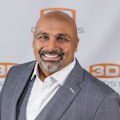Increasing clear aligner productivity and profitability
Productivity and profitability are end results of sound business principles and sound clinical processes. This is especially true for clear aligner therapy; however, it’s very easy for the allure of productivity to result in minimal profitability. You can have a high case acceptance for orthodontic services, but if your cases require multiple revisions, then you slowly but surely eat into your profitability. After all, time is money.
In this article, I would like to share some business principles and clinical practices that have allowed our practice to increase clear aligner productivity (number of cases we are doing) and profitability (income per case).
Increasing number of cases
Our office has decided to take a mathematical approach to increasing case acceptance for clear aligner therapy. What do I mean by this? We are working on getting more “at bats” to talk about tooth movement and using a show-and-tell strategy. For this to happen, we have implemented digital impressions for all new patients and consultations. Having digital impressions allows our team to better show our patients their conditions and utilize real-time simulations to show them what’s possible. We have seen a significant uptick in our patients’ interest in clear aligner therapy since implementing digital impressions into our new-patient experience. In fact, this has been the single most effective strategy to date.
Creating awareness and interest is the first step, but it’s only half the equation. The next step is to get people to accept and pay for treatment. For this, we have implemented a “price-versus-affordability” strategy. Patients don’t buy on price, but instead on what fits into their budgets, which means finding the right monthly payments. So instead of presenting orthodontic treatment as $5,000, we now present it as “$0 down and $200 per month.” It’s amazing the difference a few words make in gaining case acceptance.
Another strategy for increasing the number of cases is what I refer to as “subliminal marketing.” This is the marketing that is done in your office without direct interaction with the patient. In other words, letting your patients know you provide this service without directly telling them and getting them to inquire about it. To do this, we put large digital signs in each operatory and the lobby. These digital signs serve as a “menu of services” for our patients. The signs display various images in rotation and of course emphasize clear aligner orthodontics.
I encourage you to strongly consider implementing digital impressions, presenting treatment as monthly payments, and having digital signs if you want to increase the number of clear aligner cases you start.
Increasing case profitability
When discussing profitability of clear aligners, the first thing most dentists think about are lab fees. While having a less expensive lab fee is nice and helps profitability, minimizing chair time and team time has a far greater effect. The reduction in chair time comes from several different areas: better up-front treatment planning, reduction in number of attachments, minimizing and sequencing interproximal reduction (IPR), and fewer case revisions.
When it comes to treatment planning, the most important thing I have done is clarifying which cases we will tackle in our practice. We treat only adult relapse cases and adult cosmetically driven cases (movement of teeth that show in the smile). So, basically, if the procedure requires molar movement or the patient is an adolescent, I refer the case out. Being specific allows us to focus on cases that are generally easier to manage and thus more profitable.
The initial treatment plan is critically important with clear aligners. Unlike traditional brackets and wires, because the aligners are all made in advance, you can’t easily adjust your plan by moving a single bracket or adjusting a wire. Any changes or adjustments require a complete revision: new impressions, new planning, new attachments, and new aligners. So there should be greater emphasis on the initial computerized treatment plan. The dentist should engage in greater training and feedback to marry the plan the patient desires with true capabilities. Another aspect is ensuring the aligner manufacturer provides an idealized initial setup, preferably one done directly by a trained orthodontic professional. The extra time spent on the initial treatment plan will pay off in spades in better outcomes and fewer revisions along the way.
Another aspect that can assist with treatment planning is inclusion of 3-D cone beam computed tomography (CBCT) into the diagnosis and treatment planning process. Having 3-D imaging allows for better visualization of root movements and better assessment of case difficulty. For example, how much tipping can be accomplished without moving the teeth outside of the bony complex or in teeth that already have a bony dehiscence? Remember. tooth movement isn’t just about moving the crown, but also roots. We thus want to include that data in our protocol.
Let’s talk about what I refer to as the necessary evils of aligner therapy: attachments and IPR. Simply put, it is impossible to perform most adult cases without these; however, these items are direct causes for cases not tracking properly. Attachments help hold the aligner in place to help direct the correct forces to the tooth and create movement. It’s critical that the aligner tray completely engage the attachment for it to be effective. When a case has multiple attachments, you simply have more potential areas where the trays may not completely engage, which leads to a case requiring revisions.
When it comes to IPR, it is important for the dentist to provide the prescribed amount properly and in a timely fashion. IPR is necessary when there is a tooth space and size discrepancy. IPR also reduces the “friction” between teeth, allowing them to move more freely. Inadequate IPR will lead to teeth not moving completely, and excessive IPR will lead to spaces remaining. Poorly done IPR can even lead to ledges and/or gouges in teeth, which can cause other issues down the road. Creating a plan that minimizes the number of attachments and amount of IPR will lead to fewer case revisions.
Adding clear aligner therapy to your practice can help boost production and add a new service that patients want. Just as with all procedures, there are business and clinical skills that help make it more enjoyable, predictable, and worthwhile. I am confident that if you implement these business and clinical strategies, you will increase the number of cases you do and become more profitable.
TARUN AGARWAL, DDS, is a speaker, author, and key opinion leader. His commonsense approach to business, dedication to clinical excellence, and down-to-earth demeanor have made him a recognized educator. To hear more from Dr. Agarwal, listen to his podcast, T Bone Speaks Dentistry.
About the Author
Tarun Agarwal, DDS
Tarun Agarwal, DDS, says the solo dentist is taking a beating from all sides, with pressure about fees from dental insurance companies, competition from large dental groups, as well as challenges with employees from a new and different generation. Despite this, Dr. Agarwal continues to believe that dentistry is the best profession in the world, with more opportunity than ever. He is committed to sharing a commonsense approach to sustainable practice growth. By focusing on clinical excellence, patient-centric business management, and a dental team empowered to embrace an ownership mentality, he is helping dentists work smarter, not harder. You may contact Dr. Agarwal at [email protected].
Read Dr. Agarwal's DE Editorial Advisory Board profile here.

